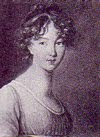
Vanity Fair, Chapter IV - The Knitted Purse
Beware Spoilers
“…this arrangement left Mr. Joseph Sedley tête-à-tête with Rebecca, at the drawing-room table, where the latter was occupied in knitting a green silk purse… And as he talked on, he grew quite bold, and actually had the audacity to ask Miss Rebecca for whom she was knitting the green silk purse? ….”For any one who wants a purse,” replied Miss Rebecca, looking at him in the most gentle winning way.
[And the next day:]
“…Jos was left alone with Rebecca, who had resumed her work, and the green silk and the shining needles were quivering rapidly under her white slender fingers… “What a beautiful, byoo-ootiful song that was you sang last night, dear Miss Sharp...…my dear Miss Sharp, do sing it”…”Not now, Mr. Sedley,” said Rebecca, with a sigh. My spirits are not equal to it; besides, I must finish the purse. Will you help me, Mr. Sedley?” And before he had time to ask how, Mr. Joseph Sedley of the East India Company’s service was actually seated tête-à-tête with a young lady looking at her with a most killing expression; his arms stretched out before her in an imploring attitude, and his hands bound in a web of green silk, which she was unwinding.
In this romantic position Osborne and Amelia found the interesting pair, when they entered to announce that tiffin was ready. The skein of silk was just wound round the card; but Mr. Jos had never spoken.”
Two highly significant scenes in one of the masterpieces of English literature. A young lady engaged in demure yet useful work about which questions may be asked and conversation made without impropriety in an atmosphere fraught with tension, unease and expectation. Rebecca is knitting a purse, a mindless project, which, retrospectively, is amusing as Becky Sharp is one of the most calculating and ruthless women in literature, completely worthy of her surname. The purse may serve as an innocent (that is, a not too personal) gift and a display of her domestic talents apart from its monetary and sexual symbolism. That she chose to knit this specific item while husband-hunting is appropriate especially since she can only provide the purse and not the fortune thus handicapping her in the marriage stakes. Her attempts, however, to entrap the foolish Jos Sedley with her carefully planned “gentle winning way” and later with “his hands bound in a web of green silk, which she was unwinding” fail miserably for Rebecca but those interested in the history of knitting gain quite a bit of information. The “shining needles” which “were quivering rapidly under her white slender fingers” must refer to metal needles. I picture those commonly seen in paintings from the 18th (see my posts from March 4th and March 18th, 2008.) The silk was purchased in skeins and was then to be wound around a card. Was this a card of home production or a shop or distributor’s card? Was the “web” merely a literary analogy or had Rebecca dropped the skein (conveniently, I would think) and then had to request assistance to untangle it, or was she merely winding the length of a regular skein around a card. What was the length of these skeins? Becky had already knit a considerable part if not almost all of the purse for she refused to sing again (a coy trick) in order to finish the purse, implying that she preferred a productive instead of an entertaining use of her time. She was, perhaps, winding the last needed skein unto a card. How many skeins did a purse require? As for the colour, green was a traditional choice for this kind of purse in the belief that it brought good luck though not for Becky in this case.
In A History of Hand Knitting (Interweave Press, 1987), Richard Rutt mentions that modern editors of Thackery suggest that since Vanity Fair was published in 1847, this image of Becky knitting may not be an accurate one of a young woman's drawing room activity of thirty some years before. This interests me especially in relation to other knitting in the novel which I shall discuss in a future post.
I cannot find a knitting silk that is fine enough to reproduce Becky’s purse so instead I am using dark green DMC 25 Mouline Special embroidery floss on 1.75mm needles at a gauge of 10 stitches/inch.














